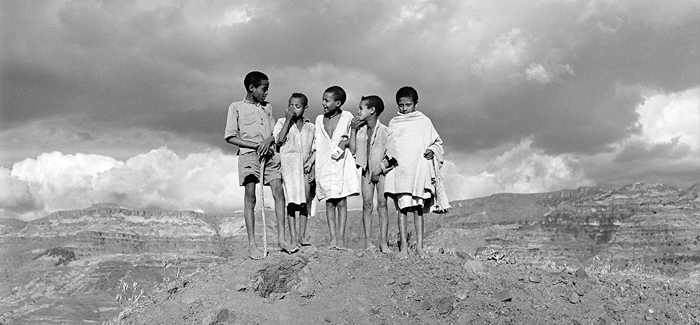
In Lalibela, Ethiopia, “we hiked out a long ridge followed by a dozen cheerful boys, each claiming to be an orphan in need of a pair of shoes,” Snyder writes. (Photography by John Snyder, AB’56)
John Snyder traversed Ethiopia seeking inspiration for a screenplay. Instead he captured a landscape about to disappear.
It was a saga to rival Lawrence of Arabia, John Snyder thought. In the middle of the 19th century, Tewodros II, only 35 years old, rose to power in Ethiopia. The young emperor sought to abolish slavery, reform taxation, and make other improvements; he made enough progress to be revered in the country a century and a half later. He befriended two Englishmen, hoped to learn from Western technology to advance his country, and came to adore Shakespeare. But his ambition, paired with a temper fired hot after a series of tragic losses, earned him enemies throughout his country—and eventually provoked the British to send an army after him.
Fascinated by the emperor’s rise and fall, Snyder, AB’56 (Class of 1954), set out on his own Ethiopian quest in 1972. A writer and artist who splits his time between New York City and North Carolina, Snyder left rural South Carolina in 1952 for the Hutchins College. In the early 1970s he was doing marketing for a New York carpet mill when he read Alan Moorehead’s absorbing history of Westerners in Africa, The Blue Nile (Harper and Row, 1962). Snyder, who had studied film writing at the New School, thought the tale of Tewodros’s rise and fall “had everything ... genius, epic drama, and a spectacular locale.” It would make a knockout film, and he would write it, first traveling to Ethiopia for research.
Following the same rugged path Tewodros took on his collision course with the British, Snyder traveled by foot, mule, bus, and Land Rover across a country that was still essentially premodern. With him were his new wife, a local translator, and a professor of African history who knew the country well. He also had a twin-lens reflex Mamiyaflex C-33 Professional camera and enough rolls of 120 film to take almost 500 photographs.
The screenplay never materialized, but last year Snyder published more than 90 of the photos in Crossing Ethiopia: A 1972 Photographic Journal Retracing the Last March of Emperor Tewodros to Magdala (Smith/Kerr). The platter-sized coffee table book has starkly gorgeous landscapes of a world half-earth, half-sky; cumulus clouds, captured with a red filter, that seem transplanted from a John Constable painting; a bell and a mortar in the grass, lonely relics of Tewodros’s reign that invoke “Ozymandias”; and faces of Ethiopians, young and old, Christian and Muslim.
The pristine world in these images has vanished. “There was absolutely no garbage,” Snyder recalls, “no plastic at that time. And there were no stores,” only local markets selling local goods. Two years later, revolution came to Ethiopia, followed by famines that savaged the country. Today the population has grown threefold or more since Snyder’s visit, and a road connects the end points of the journey that so tested his party. His photos, which he has donated to Addis Ababa University’s Institute of Ethiopian Studies, are among few records of what this part of the country used to look like. Donald Levine, AB’50, AM’54, PhD’57, UChicago sociology professor emeritus and author of two books about Ethiopia, says visitors at this time had “the rare privilege of being witness to the old historic order; you felt like you were living 1,000 years ago in a culture that had been preserved.”
The brilliant, destructive, but affecting figure of Tewodros isn’t easily grasped or forgotten, and the idea of a film never quite let go of Snyder. (Levine named his son Theodore after the emperor.) Crossing Ethiopia gave Snyder a chance to tell this grand historical character’s story. “He would see through subterfuge and he hardly slept,” Snyder says. “A driven, driven person. Unfortunately he did a lot of bad stuff too.” The worst came in the 1860s.
In 1858 Tewodros lost his young wife, Tewabech, whom Snyder calls “a leveling influence.” Two years later, his confidantes Walter Plowden, the British consul to Ethiopia, and John Bell, who introduced him to Shakespeare, were dead at the hands of rival tribes. A new consul, Charles Cameron, arrived from England with a gift of pistols engraved to the emperor from Queen Victoria. When Tewodros wrote back to her and no response came (the letter never reaching her), he imprisoned Cameron and several European missionaries. After a series of failed negotiations, Britain’s Indian army invaded, arriving in October 1867 with advanced weapons and 14,700 men to fight the Ethiopian emperor’s 5,000. As they began their march from the Red Sea to Magdala, where the prisoners were held, Tewodros traveled east from Debra Tabor to the same destination.
With enemies of the emperor rife in the country, the British had relatively safe passage. The following April, defeat certain, Tewodros took his own life using one of the gift pistols. First, though, he released the prisoners unharmed, losing his only leverage in the conflict. Why? Nobody knows. Snyder speculates that “he really admired their technology and the fact that they had beaten him, and he almost felt that they had earned it.” Whether mercy, honor, or simple fair play, the act, for many, tipped the balance of Tewodros’s ambivalent legacy toward tragic hero.
